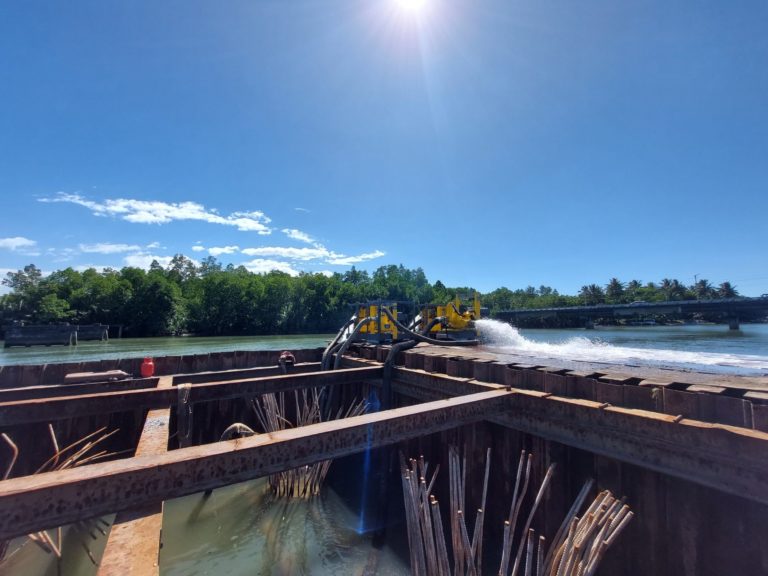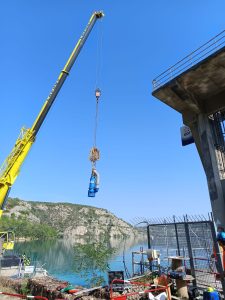Critical Dewatering Operations Ensure On-Time Delivery of Bridge Construction Project in the Philippines

Critical Dewatering Operations Ensure On-Time Delivery of Bridge Construction Project in the Philippines (Image source: Atlas Copco)
The island of Mindanao is central to the Philippine government’s plans to boost the country's economic progress. It is the second-largest island after Luzon, covering 97,530 square kilometers, and has huge potential as a hub for commerce, tourism, and clean energy. The island’s transformation depends on plans to ease congestion and improve connectivity. More than 70 high-impact infrastructure flagship projects amounting to PHP 2.4 billion are planned or already underway, including the Davao Public Transport Modernization Project, Mindanao Railway Project, Samal Island-Davao City Connector Bridge, Davao City Expressway, the Panguil Bay Bridge and the Dipolog-Dapitan bridge.
Dewatering challenges
As part of the national infrastructure development plan, the construction of the bridge to connect the cities of Dipolog and Dapitan in western Mindanao was projected. Most of the bridge’s structural elements are positioned out in the water, so dewatering plays a critical role in keeping the project on track. This involves draining and removing groundwater and surface water to enable the bridge columns and foundations to be constructed safely.
In addition to coping with the usual challenges of underwater construction, the project presented some additional problems. The amount of water requiring displacement can be highly variable in this region, depending on the time of year. There is heavy rainfall in Mindanao from July to November: a phenomenon being exacerbated by climate change. This heavy rainfall not only adds to the volume of water, it leads to run-off which means there is also a higher concentration of solids in suspension.
Leading civil engineering contractors in the region needed a dewatering solution that was sufficiently robust and reliable for deployment in these harsh conditions, while also delivering powerful performance and versatility. They turned to long-term partner Atlas Copco to meet the challenging dewatering specifications required on the Dipolog-Dapitan bridge project.
Pumping solutions
Atlas Copco delivered several units of two models from its self-priming centrifugal dewatering pump portfolio: the skid-mounted PAS 200MF 310 and VAR 6-250 trailer pumps. The PAS and VAR ranges are meticulously designed to provide high performance, reliability, and user-friendliness in many challenging environments, including construction, mine site dewatering, floodwater removal, and other municipal applications, such as sewage bypass.
The PAS 200MF comprises an air separator unit and vacuum pump and features rapid automatic priming. The highly efficient dewatering unit can handle liquids with solids up to 100mm in suspension and copes effortlessly with suction heights.
The VAR 6-250 wet prime pump can handle solids up to 75mm. It is trailer-mounted, which makes it particularly suited to flood control due to its ease of deployment. Together, the PAS and VAR solutions offer the performance and flexibility required to deal with the dewatering challenges of the Dipolog-Dapitan bridge construction project.
As well as dewatering equipment, Atlas Copco provides local after-sales support which gives the local constructor additional confidence and immediate access to technical assistance should they require it.
Saving time, improving efficiency
The deployment of the PAS and VAR dewatering pumps is delivering tangible benefits compared to traditional dewatering equipment and helping to keep the bridge project on track for completion in June 2024. In addition to providing operators and end-users with the solution that best fits the project's particularities, Atlas Copco’s expertise enabled them to improve productivity to meet operational deadlines with reliability.
Commenting on the project Jeffrey Sedenio, Philippines Country Manager at Atlas Copco Power Technique says: "We are proud to partner with the leading civil engineering constructors in the region, pushing for the development of the Philippines. Our collaboration on various projects, including the boundary bridge connecting Dipolog and Dapitan, exemplifies our shared commitment to innovation, efficiency, and quality. Together, we're not just building structures; we're forging connections, driving progress, and shaping the future of infrastructure on Mindanao and beyond."
Source: Atlas Copco AB





